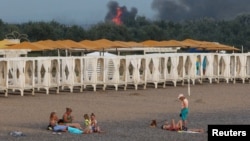Ukraine marks six months on Wednesday since Russia invaded the country in what Russian President Vladimir Putin calls a “special military operation.”
Ukraine and its Western backers accuse Moscow of waging an unprovoked war of aggression with the aim of grabbing land and erasing Ukrainian national identity.
Putin said his aim was to disarm the country in order to preemptively ensure Russia’s own security against NATO expansion and to rid it of far-right nationalists who he said threatened Russia.
Here is a timeline of the main events in Ukraine’s political history since it won independence from Moscow in 1991.
1991: Leonid Kravchuk, leader of the Soviet republic of Ukraine, declares independence from Moscow. In a referendum and presidential election, Ukrainians overwhelmingly back independence and elect Kravchuk president. He is replaced by Leonid Kuchma in 1994, when Ukraine also agrees to relinquish its nuclear arsenal — the world’s third largest, inherited from Soviet times - in return for security assurances based on respect for its independence and sovereignty under the Budapest Memorandum signed also by Russia, the United States and Britain.
2004: Pro-Russian candidate Viktor Yanukovich is declared president but allegations of vote-rigging trigger protests in what becomes known as the Orange Revolution, forcing a re-run of the vote. A pro-Western former prime minister, Viktor Yushchenko, is elected president.
2005: Yushchenko takes power with promises to lead Ukraine out of the Kremlin’s orbit, towards NATO and the European Union. He appoints former energy company boss Yulia Tymoshenko as prime minister but after in-fighting in the pro-Western camp, she is sacked.
2010: Yanukovich defeats Tymoshenko in a presidential election. Russia and Ukraine clinch a gas pricing deal in exchange for extending the lease for the Russian navy at a Black Sea port on Ukraine’s Crimea peninsula.
2013: Yanukovich’s government suspends trade and association talks with the EU in November and opts to revive economic ties with Moscow, triggering months of mass rallies in Kyiv. Putin accuses the West of inciting and supporting the protests.
2014: The protests, largely focused around Kyiv’s Maidan Square, turn violent. Dozens of protesters are killed. In February, the parliament votes to remove Yanukovich, who flees. Within days, armed men seize parliament in Crimea and raise the Russian flag. Moscow annexes the territory after a March 16 referendum which shows overwhelming support in Crimea for joining Russia.
April 2014: Pro-Russian separatists in Ukraine’s eastern Donbas region declare independence. Fighting breaks out and continues sporadically into 2022, despite frequent ceasefires.
July 2014: A missile brings down passenger plane MH17 over eastern Ukraine en route from Amsterdam to Kuala Lumpur, killing all 298 people on board. Investigators trace back the weapon used to Russia, which denies involvement.
2017: President Petro Poroshenko, a pro-Western billionaire businessman in power since May 2014, clinches an association agreement with the EU on free trade of goods and services. Ukrainians also gain the right to visa-free travel to the EU.
2019: Former comic actor Volodymyr Zelenskyy defeats Poroshenko in an April presidential election on promises to tackle endemic corruption and end the war in eastern Ukraine. His Servant of the People party wins a July parliamentary election.
2021: Zelenskyy appeals in January to U.S. President Joe Biden to let Ukraine join NATO. Russia masses troops near Ukraine’s borders during the spring in what it says are training exercises. In December Russia presents detailed security demands including a legally binding guarantee that NATO will give up any military activity in eastern Europe and Ukraine. In response, NATO repeats a commitment to its “open-door” policy while offering “pragmatic” discussions of Moscow’s security concerns.
2022: In a televised address on February 21, Putin says that Ukraine is an integral part of Russian history, has never had a history of genuine statehood, is managed by foreign powers, and has a puppet regime. Putin signs agreements to recognize the breakaway regions in eastern Ukraine as independent and orders Russian troops there. The West imposes more economic sanctions on Russia. On February 24, Putin declares war in a pre-dawn televised address and Russia launches a three-pronged invasion, targeting Ukrainian forces and air bases with missiles and artillery and striking areas in cities. As tens of thousands of people flee their homes, Zelenskyy orders a general mobilization.





